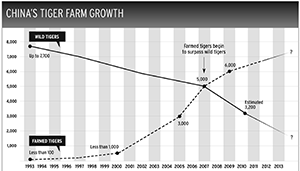The number of tigers living in the wild has dropped to the shockingly low figure of 3,200, down from 100,000 a century ago. But nearly as shocking is this statistic: An estimated 5,000 to 6,000 tigers are being farmed today in China, their bones steeped in alcohol to make tiger bone wine, their meat sold, and their skins turned into rugs for members of China’s wealthy elite.

International conservation experts say that this trade, officially sanctioned by the Chinese government, poses a direct threat to the world’s remaining wild tigers because increased availability of these bones and pelts fuels demand that actually strengthens the incentive to poach wild tigers. Among the leading critics of tiger farming is Judith Mills, a veteran of undercover investigations exposing illegal wildlife trade.
In her new book, The Blood Of The Tiger, Mills — who has been campaigning for tiger conservation for two decades while working for the World Wildlife Fund, TRAFFIC, Conservation International, and Save the Tiger Fund — makes a passionate case against tiger farming. In an interview with Yale e360, Mills explains how these magnificent creatures are bred like cattle for their body parts, how tiger farms further stimulate demand for wild tigers, and how some conservation groups have chosen not to confront the Chinese government about the farms, allowing them to operate unchecked.
Yale Environment 360: In 1993, bowing to international pressure and the possibility of sanctions, China imposed a ban on all trade of tiger bones used in traditional Chinese medicine. But at the same time the breeding of captive tigers was beginning to get off the ground in that country. How did you first become aware of tiger farming in China?
Judith Mills: I first went to China in 1991 because I was investigating the trade in bear gall bladders. And while I was on that trip I was taken to a mink farm that had a handful of tigers in cages. And there the staff showed off a handwritten ledger that was filling up with orders for tiger bone from medicine companies. So that’s how I became aware.
“This is about products looking for a market rather than a market looking for products.”
e360: Ostensibly, these farmed tigers were going to be used in programs to reintroduce tigers in the wild, but you write that the explosive growth of tiger farms in China had nothing to do with conservation and everything to do with business. So what were the owners of these farms at this point banking on?
Mills: Basically, a tiger farm is a feed lot for tigers where they’re bred like cattle for their parts to make luxury goods, such as tiger bone wine and tiger skin rugs. This is about wealth, not health. Traditional Chinese medicine no longer uses tiger bone, nor wants to, because it wants to go global and it does not want to be blamed for the extinction of wild tigers. Furthermore, polls in China show that most Chinese people don’t want tiger products or tiger farming. Many of them believe that it actually punishes China’s international image. So this is about a handful of investors poised to launch a multi-billion-dollar-a-year business, primarily in tiger bone wine, but also from tiger skins, tiger meat, etc. This is about products looking for a market rather than a market looking for products.

e360: You just alluded to the tiger bone wine. Under current Chinese law is that illegal?
Mills: I think this is one of the ways in which I and other members of the conservation community fail to connect the dots. When China banned the tiger bone trade in 1993 we thought that meant the end of the tiger trade and the end of tiger farming. In 1994, I noticed the number of tigers on farms was actually increasing. And today there are 5,000 to 6,000 tigers on farms in China; some of them with active wineries. What we didn’t understand until very recently is that ban in 1993 did not supersede China’s wildlife protection law, which was crafted in the 1980s and actually mandates the farming and consumption of tigers and other endangered species.
e360: So while technically tiger bone wine may be a product that’s illegal, purveyors of it feel confident that they can sell this wine out in the open without any government crackdown?
Mills: We in the conservation community have been trying to get clarification on this for twenty years. The State Forestry Administration, which is in charge of tiger protection and also tiger farms, has been quite opaque and not at all straightforward on answers to these questions. It is clear that they have allowed some sort of limited legal trade in tiger bone wine and tiger skins and it is also clear that because the State Forestry Administration allowed these farms to go from fewer than 100 animals in 1993 to perhaps 6,000 today that there is some sort of tacit promise that trade will be open.
“If even a tiny fraction of China’s 1.4 billion people seek wild tiger products we could lose wild tigers overnight.”
The reason the United States and other countries were threatening trade sanctions against China in the 1990s was because China’s consumption of tiger parts and products was endangering tigers throughout their range. The problem with tiger farming is that it stimulates demand for tiger products, which stimulates poaching of wild tigers because products from wild tigers are considered superior, more prestigious, and they’re exponentially more valuable. Some people are actually investing in these products from wild tigers as they would invest in gold or rare art. And looking at it mathematically, if even a tiny fraction of China’s 1.4 billion people seek wild tiger products we could lose wild tigers overnight.
e360: So just to reiterate, we’re not talking about the use of a product in traditional Chinese medicine, steeped in tradition and then Westerners imposing their value system on a culture. You are saying that we’re talking about a manufactured demand for luxury goods.
Mills: In 1993 I would say it was just what you said — an imposition of Western values on the traditional Chinese medicine industry. But since that time the industry itself has led campaigns in the United States, in Australia, and even in China against the use of tiger products. And tiger farming has basically stayed alive and stimulated a demand that was all but dead by the mid-1990s.
e360: What’s in it for the government to support these farms?
Mills: That’s an excellent question. The State Forestry Administration actively promotes tiger farming. It has invested money in tiger farms and wineries on tiger farms. I don’t know whether officials who are promoting tiger farming are doing it out of allegiance to the wildlife protection laws mandate or if they themselves have some vested interest. I will say that they certainly protect tiger farming with a great deal of vehemence. So, again, I think this is a question that the international community needs to ask and it is one of the reasons why I wrote this book. I would like to know if President Xi Jinping knows what’s going on with tiger farming and this ministry’s promotion of tiger farming.
“The State Forestry Administration has invested money in tiger farms and wineries on tiger farms.”
e360: Talk about the condition that farmed tigers are kept in.
Mills: They are not unlike the conditions in any battery farms that raise cows, pigs, chickens. They are kept in small cages, the females are bred and their cubs are taken away from them almost immediately so that they can breed again. And the males run around in herds. Anyone who is familiar with wild tigers will know that in the wild these are solitary animals. So basically they are raised in very un-tiger-like conditions and in many cases they aren’t fed properly.
e360: In 2007, the U.N. Convention on International Trade in Endangered Species (CITES) voted that tigers should not be bred for trade in their parts and that tiger farming should be phased out. Since then, what has CITES done to pressure China to carry out that resolution?

Mills: That decision has been steadfastly ignored by China’s State Forestry Administration. In 2010 [Russian President] Vladimir Putin hosted a tiger summit and at that tiger summit talk of tiger farming was forbidden.
e360: What do you mean by forbidden?
Mills: Forbidden. NGOs, the World Bank, and probably country delegations were warned against mentioning tiger farming by the State Forestry Administration. There has been a steady campaign of threats and intimidation that has resulted in censorship and/or self-censorship on the part of the people who should be speaking up rather loudly about this threat to the survival of wild tigers.
e360: In your book you write about the undercover work carried out by the NGO the Environmental Investigation Agency, which exposed government-sanctioned trade in tiger skins, as well as this booming business in tiger bone wine. EIA investigators even found evidence that tiger bone wine was “a popular gift for winning favor from government officials.” EIA presented this evidence at a CITES meeting in 2013 and the reaction was underwhelming. Tell me what happened.
Mills: I believe that CITES and the NGOs that orbit CITES have become afraid to speak up about this issue because of threats from China’s State Forestry Administration.
e360: The nature of those threats?
Mills: Threats such as, “If you want to have a program studying wild tigers in China you will not mention tiger farming at CITES. Or if you bring this up at CITES we will kick everyone in your China office out of the country.” I don’t know the exact nature of the threats to government bodies or to the World Bank, but I do know that threats have been made.
e360: At a CITES meeting a few months ago tiger farming was discussed and a number of recommendations were adopted having to do with tiger farming. Tell me a about those resolutions and if you see this as progress.
Mills: I do see it as progress. I was heartened to learn that CITES had found the courage to begin pursuing the decision against tiger farming again. But I was taken aback when I learned that China had been given the chairmanship of the working group overseeing the standing committee’s orders regarding tiger farming. I look forward to the outcome of that working group to see whether or not meaningful progress will be made or if it will be just another opportunity for the State Forestry Administration to work around the decision against tiger farming.
I really believe that we may lose wild tigers because of this, and it’s unconscionable that it hasn’t been talked about properly since 2007.
“For a long time there have been ministries within the Chinese government that are uncomfortable with tiger farming.”
e360: I also find it interesting that at that meeting China admitted for the first time that it has legalized the trade in tiger skins.
Mills: Yes, so that was a harrowing moment. Of course, EIA has been saying this for years. What worries me about that admission is that I believe that China may be readying itself to lift its ban on tiger trade, which also is a ban on trade in rhino horn. And as you may know, China is hoping that CITES will approve a deal in 2016 that would allow South Africa to sell rhino horn to China legally. China has already begun farming rhinos and I fear that this same scenario is going to unfold for rhinos. And a fully reopened Chinese [tiger] market will have an insatiable demand and, again, wild products are exponentially more valuable. I don’t see how the remaining 3,000 or so tigers can last long in the face of that kind of demand.
e360: In your estimation are there forces in the Chinese government that might be pushing for an emphasis on conservation?
Mills: Well, there is some very good news coming out of China in that there is a growing movement made up of Chinese people, without any Western backing, to change the law and to take out the mandate for farming and consumption of tigers and other endangered species such as bears, etc. For a long time there have been ministries within the Chinese government that are uncomfortable with tiger farming. But these ministries have been reluctant to speak out in defiance of the State Forestry Administration. One of my great hopes in China comes from the efforts of WildAid and its very successful enlistment of power brokers, opinion makers, and celebrities in China who are now speaking out and reaching a broad audience in China with a message that when the buying stops, the killing can too.
e360: In your book you write about the successful campaign to discourage the eating of shark fin soup in China. So you see lessons in that campaign that might apply to the tiger trade?
Mills: I absolutely see hope in the example of shark fin soup, and I see hope actually in the China/U.S. agreement on climate.
e360: How so?
ALSO FROM YALE e360Ivory Trade Debate: Should the Global Ban on Ivory Be Lifted?

Mills: First, one of the excuses the State Forestry Administration uses for not complying with the CITES decision against tiger farming is the fact that the United States has at least 5,000 captive tigers and nobody knows exactly where all those tigers are or what happens to them when they die. And so China and other countries frequently ask why should China phase out tiger farming when the United States has not dealt with its captive tiger problem. I think that’s a legitimate question. And so what I see in the climate agreement is a template for a China/U.S. agreement on tigers, where each of them would pledge to address their respective tiger problem that is contributing to greater or lesser degrees to the pressure on wild tigers.
e360: What needs to happen in the next couple of years in order to save tigers in the wild?
Mills: I would venture to say that most people on the planet don’t know that the world is in danger of losing our wild tigers to these farms. And so I think the most important thing right now is to talk about the problem. But I think it’s also very important that NGOs find the courage to get back in the ring. I think it’s very important for the United States and other countries to find the courage to ask China if there is a commitment to commodify tigers that goes all the way up to the top, to President Xi Jinping, or is this just an old-school mandate that’s left over from the 1980s that needs to be — and can be — changed. Otherwise we’re ceding the existence of wild tigers.